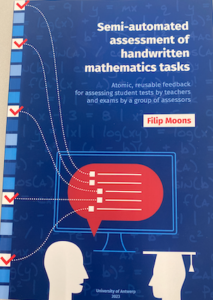Promotie Filip Moons

|
Semi-automated assessment of handwritten mathematics tasks. Atomic, reusable feedback for assessing student tests by teachers and exams by a group of assessors
Promotie Filip Moons, Universiteit van Antwerpen, 6 september 2023, 17:00 u mathsa.uantwerpen.be (livestream en pdf proefschrift) |

|
digitaal te beoordelen, kan feedback bewaard en vervolgens hergebruikt worden. Dat kan uitgebreidere feedback, tijdswinst en verhoogde interbeoordelaarsbetrouwbaarheid opleveren. In dit proefschrift werden twee semi-automatische beoordelingsmethoden ontwikkeld en onderzocht.
This brings us to the idea of semi-automated feedback and assessment: by correcting handwritten tasks digitally, feedback can be saved and re-used. This could lead to more elaborate feedback and interesting time savings, but also opens up possibilities to extensively monitor the individual learning process of students, and to apply adaptive differentiated instruction using Bayesian networks. A Bayesian network is a probabilistic graphical model of a student’s proficiency. We want to focus on the learning gains that semi-automated evaluation systems can offer, but also explore the reliability, time savings and acceptance levels of such systems.
Verwijzingen
- Moons, F. (2023). Semi-automated assessment of handwritten mathematics tasks. Atomic, reusable feedback for assessing student tests by teachers and exams by a group of assessors (PDF): University of Antwerp.


